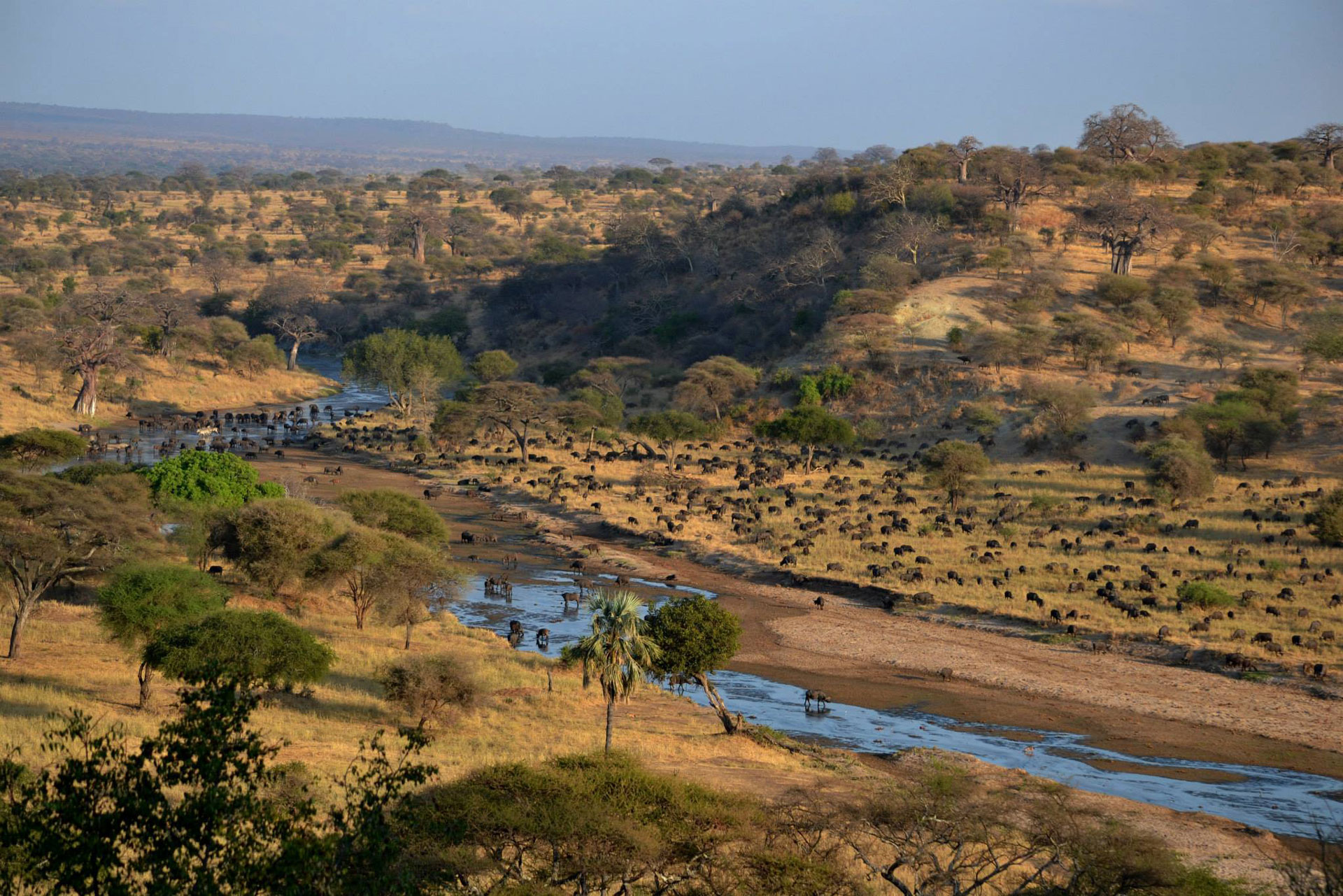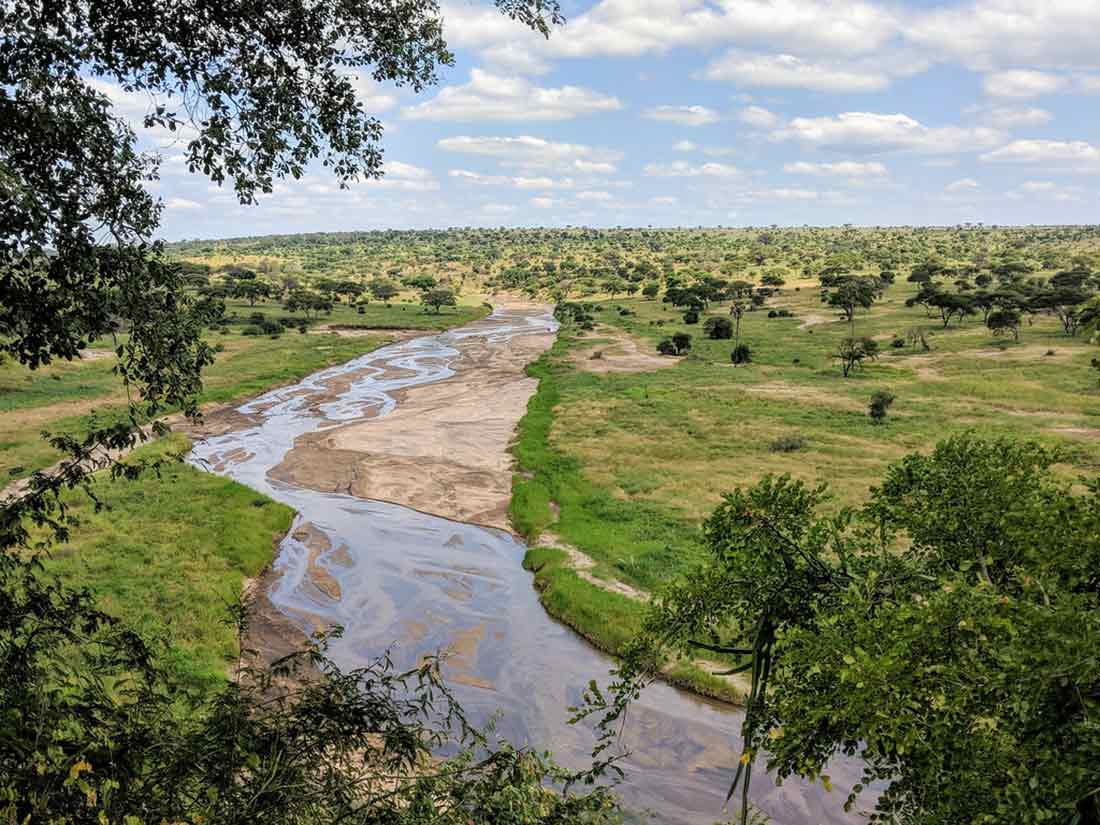Tarangire River : Tarangire National Park
The Tarangire River is a picturesque watercourse situated in the eastern region of the East African Rift Valley, traversing Tarangire National Park in northern Tanzania. The River Tarangire refers to the primary attraction of Tarangire National Park and the river’s picturesque landscape. The river’s additional source is located in the Iranagi Hills, and it discharges into Lake Burnge. The source of a river refers to the location where it begins, while the mouth of the river denotes the point at which it flows into a bigger water body or where a stream converges with a major river, thereby defining the river’s mouth.
The Tarangire River serves as a vital water source for numerous wildlife in Tarangire National Park, particularly during the dry season from June to October, when animals congregate at the Tarangire River to hydrate due to the elevated temperatures. This is highly intriguing and remarkable. Moreover, Tarangire National Park derives its name from the Tarangire River that traverses the area. It encompasses savannah grasslands, acacia woodlands, and floodplains. These areas attract several creatures that inhabit Tarangire National Park, rendering the park appealing to diverse wildlife species.
To enter the park, non-residents must pay an entrance charge of $53, while Africans are required to pay in Tanzanian shillings. The fee and identification card are essential prerequisites for visitors to gain entry to Serengeti National Park and participate in its captivating activities. The entrance charge for tourists at Tarangire National Park is applicable for a single entry and remains valid for twenty-four hours. During the excursion to Tarangire National Park, both children and adults are subject to distinct entrance prices, which is both intriguing and remarkable.

Points of Interest in Tarangire National Park
In addition to the Tarangire River, there are various more tourist attractions that visitors may explore during safaris within the national park. These attributes, among others, comprise the following:
Wildlife species
Tarangire National Park is home to a diverse array of wildlife species and offers several wildlife safaris that attract tourists to the area. These animals inhabit the savannah plains, including hyenas, warthogs, antelopes, kudu, wildebeest, hartebeest, giraffes, lions, leopards, and elephants. The substantial elephant population is a prominent feature of Tarangire National Park, alongside the savannah plains, contributing to many tourist attractions.
Baobab trees in Tarangire National Park:
These trees are a notable tourist attraction that enhances the park’s scenery. The baobab trees serve as refuge for wildlife in Tarangire National Park, and are favored by elephants that polish their tusks on them, while also providing water for other animals, which is rather intriguing. The pastoralists residing in the adjacent regions of Tarangire National Park also utilized the baobab trees. The baobab trees served as the source of the plants, which is quite intriguing.
The Maasai people are the primary attraction of Tarangire National Park, renowned for their intriguing nomadic lifestyle observable during visits to the park. These reside within the confines of the national park. This group is recognized for its distinctive culture, customs, and traditional lifestyle, which is intriguing. Visitors engage with the Maasai people during their excursions to the Maasai communities, where they encounter the locals and gain insights into their traditional culture and customs. This is highly intriguing and remarkable.

Tarangire National Park Bird species:
Tarangire National Park is recognized for its many avian species, which can be observed across the park’s hills, moist floodplains, and woods. The avian species include ashy starlings, striped swallows, hornbills, ostriches, hammerkops, rufous-followed weavers, falcons, and vultures. Bird enthusiasts enjoy observing both migratory and resident bird species in the vicinity of Tarangire National Park during the wet season, which extends from November to March. This season is frequently considered the ideal time for avian observation at the location.
Methods for accessing Tarangire National Park
Various forms of transportation are available for individuals to reach Tarangire National Park, including ground transit and aerial transport. Travelers may opt to drive from Arusha to the National Park situated in northern Tanzania. Tarangire National Park is situated in proximity to major wildlife observation regions, including Lake Manyara National Park, Ngorongoro Conservation Area, and Serengeti National Park. An alternative method to reach Tarangire National Park is via air travel, facilitated by various aviation agencies who provide both scheduled and charter flights to the location.
Accommodation options in Tarangire National Park
Tarangire National Park’s upscale accommodations include Tarangire Sopa Lodge, Mawanga Lodge, Lemala Tarangire Lodge, Nimali Tarangire Lodge, Sanctuary Swala Camp, and Tarangire Treetops Lodge, among others.
Tarangire Roika Stop, Twiga Stop, Tarangire Stream Camp, Lake Burunge Rose Camp, Saingwe Rose Camp, and further midrange accommodations are accessible. The budget or basic facilities of Tarangire National Park encompass Whistling Thistle Camp, Country Hold Up and Planet Stop, among others. Numerous camping sites are available in the public park for visitors on their safari in Tarangire National Park. We invite you to experience the premier tourist attractions in Tarangire National Park, particularly the Tarangire River, which stands out as one of the park’s foremost highlights.
